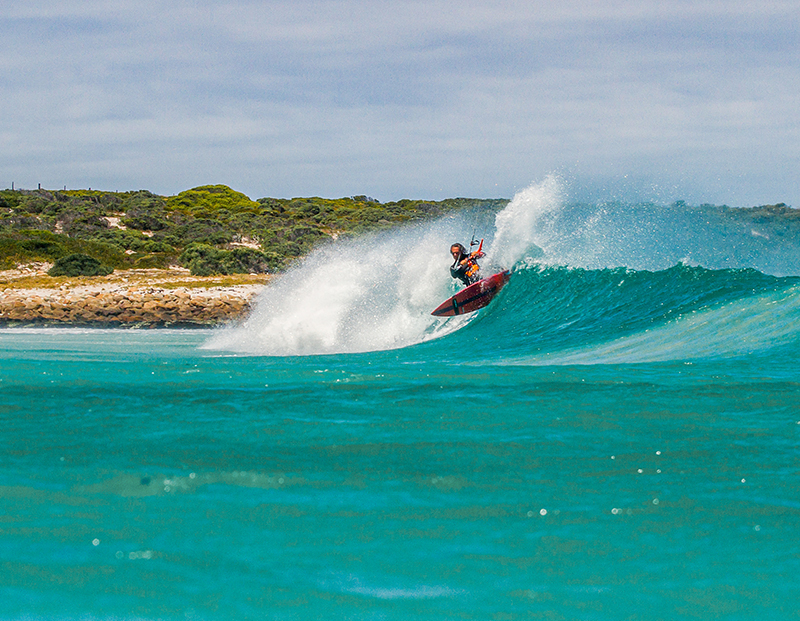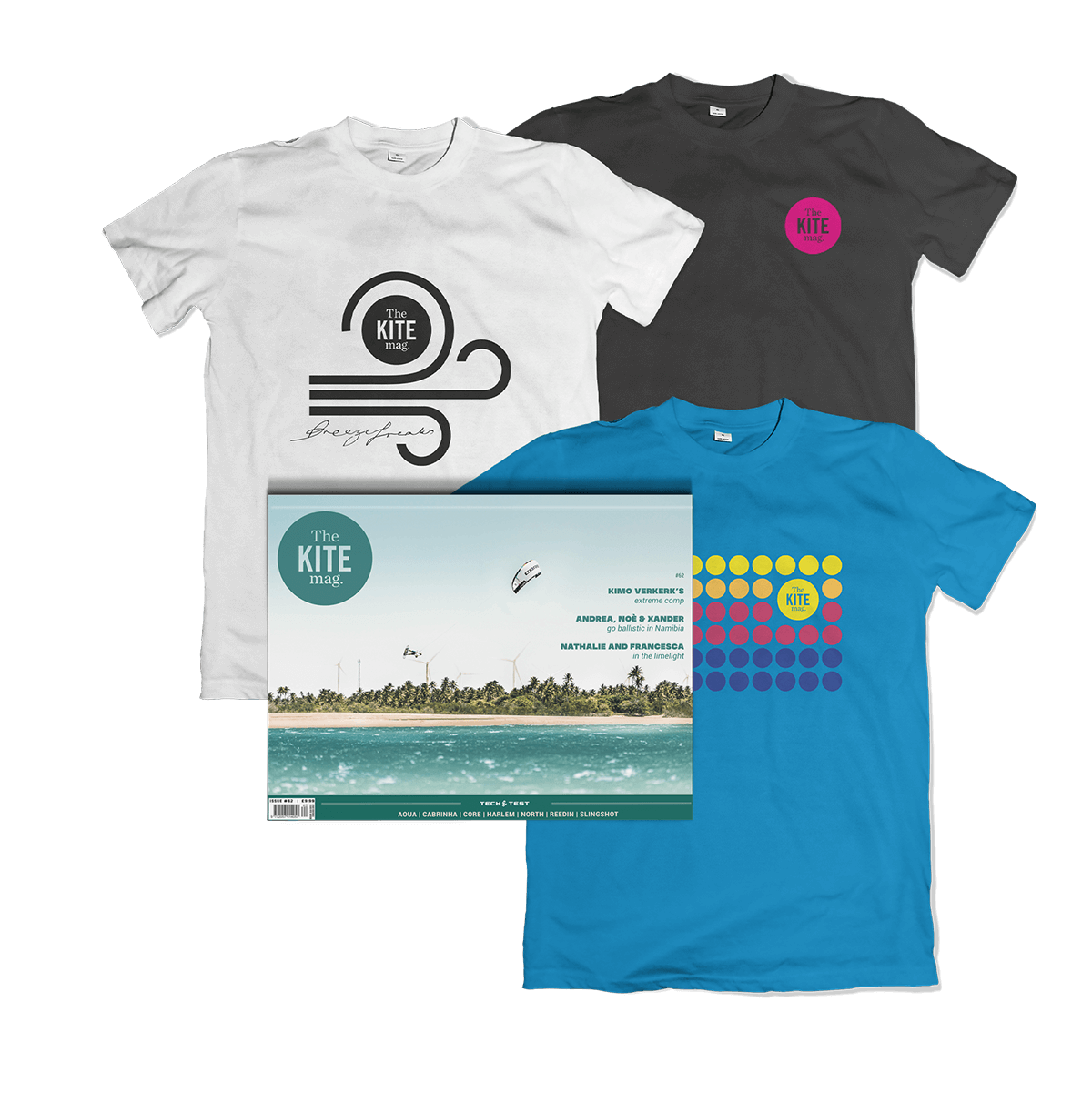Roberto Ricci can comfortably place himself as one of the ‘original’ creators. Building windsurfing boards since the early years he has ridden the wave of every watersport that has evolved since then and RRD now boasts the largest line up of any single brand on the planet. Is he letting up at all? We caught up with him to find out…
// Hey Roberto, so tell us what did you first create and ride yourself?
The first kiteboard that I made for myself was a 6'3 surfboard that I took from our line of surfboards back then, it was 1997 or 98 I believe. I basically put straps on a surfboard which is kind of what we do today with our RRD kitesurf boards. Then I cut the nose off the board just to make sure it wasn't too pointed as I was scared to get hit because I was of course wearing a leash! So I did my first downwinder with that board with a couple of windsurfing friends of mine from Castiglione where I live. That stretch was about seven miles downwind, and by the end of it I was able to stay upwind already. I was really stoked about that.
Then the first board I built for myself was in 1982, it was a windsurf board in my parents’ garage. It was built entirely out of PVC foam and it was super heavy. We were using full PVC boards, even inside was no EPS, so the board was about 25-30 kilos – for a jumping board! That was the first fun board that I shaped for myself to be able to go and jump, and I put the straps on with a small sail for over 25-30 knots of wind, and off you go, dreaming about being in Hawaii, but with your feet in Tuscany! So head in the sky, feet on the ground, it was really lovely…
// Your early endeavors weren't always successful. There was a fire in your factory in the early years, right?
Yeah, that was 1993. I had already been shaping for about seven years, and I was making some boards for my friends and team riders for the Barbados World Cup at the time, the PBA World Cup, first stop of the year. And I remember shaping those windsurf boards for Robbie Seeger, Brian Talma and other friends of mine who were just getting boards from me built in Italy, super lightweight, you know, everything custom made for the Windsurfing World Cup at the time. I was working day and night to be sure they had enough time then to go to Barbados. I was just about to finish up those boards, and I remember going in the factory and cranking the oven for post-curing the boards to get to the maximum stiffness and resistance, and I went for a pizza with some friends, and then after a couple of hours my brother called me up and said, “Look, you gotta come back home because there's been a fire in the factory.” Then when I turned on the corner of the street where my parents lived, it was like entering into a movie; the fire department were there, all the trucks just trying to extinguish this fire that was underneath my parents’ house. It was really one of the worst nightmares you can imagine. Being a young man full of energy and dreams and stuff like that, I realized that through living a big dream, and being able to now shape boards and build myself a career, and through traveling around the world, that with that lifestyle I was not really living a secure life. All my doubts and worst nightmares came in one big heavy load on my head that very moment. In the morning I woke up, and we'd lost everything, I didn't have any money in my bank account, I maybe had like a thousand dollars in the account and no insurance. So I realized how badly I fucked up. The morning after I decided to really change my life completely, and all the bad that the fire caused I was able to turn into a positive energy, and I realized that I needed to have a better approach and could not just be a beach bum any more. So in a way I was happy that happened at that time because it gave me a lot of energy and a lot of trust in myself and what I was doing. So that fire really kept me moving for quite some years, and is still burning inside of me every day when I go into the company and I see what we created together with all my people here in Italy.
// What is the Italian philosophy and how does it sit within RRD?
I would say that I can see the Italian touch or approach to the products that we build with RRD every day, mainly in the attention to the details which might not seem important to others but they're important to me and to all the project managers that we work with. Basically it can be summed up in that attention to detail which brings the right mix between ‘performance’ and ‘romance’. ‘Perf-romance’ is my oldest slogan that I used to define the company's approach to product making, so I believe that of course. First of all, a technical product has to perform and you have to have a measurable amount of performance within the product to be able to say, okay, that guy jumps higher or it's better or more maneuverable or whatever… so measurable parameters, but as equally important as it is to perform, the board or the kite has to look beautiful. They have to be in harmony. So the harmony between a performance product and a beautiful product is essential to me and it's very personal, but I think it's also really the heart and the DNA of RRD. So I see the ‘Italianity' in every product that I make through that, so the Italian philosophy can basically be summed up with this constant research for harmony in the product we make.
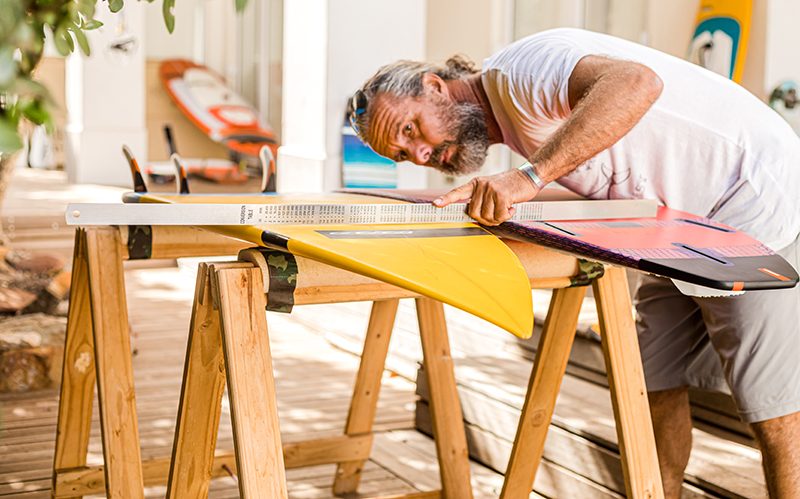
Measuring and keeping track of how it's done. The database in your brain beats any hard drives and sophisticated software.
// You mix your time between Italy and Cape Town. What does it enable you to achieve as a rider and as a brand?
Well, I decided to live for three months every year in Cape Town with my family, mainly to be able to go out in the waves, to just go kite and it is where I kite 95% of the time nowadays. We go and do other things as well, but mainly I kite in the waves when I'm in Cape Town and I test the high wind equipment. So it's the right balance that helps me to be able to combine the flat water and the warm thermal breezes of Italy with the harsh south-easterly winds and big solid swell that hits the coastline of South Africa. It keeps me motivated to go in big surf, cold water, strong winds, and it keeps me fit because I don't have much time to go in the water when I'm back in Italy. I just go foil most of the time through the spring, summer and autumn when I'm here. So it really is a very complimentary life and I just love it. And for the brand, of course, we really see it as an important added value because by being there, being able to ride, people see me, people approach me, people talk to me. They want to share my point of view. They want to understand why I'm doing that, what I'm developing, and it's just good to be in touch with a different type of market. It's very international, there's people from all over Europe who enjoy the watersports like ours, and we all know that basically 70% of the market is in Europe. So by being able to touch base with most of the European countries, you're able to kind of be in touch with 70% of the world market, which is a great asset for the brand. Plus my family loves it, my kids love it, and it couldn't be better. So yeah Cape Town is our second home.
// Which have been your most successful products and which are you most proud of?
Well, there's a lot of products which have been quite successful in our kiteboarding range, but I’ll choose two that I am proudest of. One is the Religion, the dedicated wave kite which we started in 2001. We actually came up with the first wave-dedicated kite, so wave is in our DNA. Wave is my biggest desire and I just want to go out there with a kite in my hands and just be able to ride any sized waves: small, medium, big, onshore, sideshore, whatever… I just love kiteboarding in waves! In the board range, I think it's definitely the Poison. The Poison is a twintip board, it's a unique product in the range of our kiteboards and represents a great mix between accessibility and super top-level performance. It really is the epitome of our collection in terms of twintips, and it has been really, really successful.
// Can you talk us through your RRD Factory, how this works and how it enables you to be quite fluid with the product design?
Well, it's quite simple. We have a board factory underneath my office here in Italy and I have a sail loft in Castiglione in my house, where I live in my hometown. These are the two main centers where I develop the products. Every day we make a new prototype, every week we have about two or three prototypes that go around the world, and mainly they're all tested either by myself or team riders who live here in Italy and then are tested in Cape Town and some are also taken to different parts of the world as well. Whenever I'm in Cape Town, I work with a couple of local shapers there to be able to develop and modify some of the windsurf boards and kite surfboards. I studied as a shaper in 1986, and I still want to have my hands down on the product. I really want to know how the product is made and to see if the harmony's there. This is what I love, this is probably the best part of my job. The part which is the most fun is to be able to modify a product and go back out in the water and test it, and realize how it changes. This is essential, this is the “juice of life” I call it!
// How challenging is it to have a multi-discipline line up and to keep your products innovative and true to the RRD philosophy?
Well, it's quite simple. If you have the competence and the passion to develop your line and all the products in that range then everything becomes quite spontaneous and quite, let's say, normal for any product managers to develop such a product. So the challenge is to keep a certain amount of team riders and product developers and testers all competent in each category of products. As we are a complete watersports company, ranging from windsurfing to kiteboarding to stand-up paddle boarding and surfing, and then doing wetsuits and harnesses as well, it's a massive amount of work to keep finding the right guys to develop and to be competent in each category, but this is our mission and our philosophy. We have approached the watersports business differently from a lot of companies who have differentiated with different brands for their kitesurfing products using different brand names, whereas our philosophy was always to keep everything under one name, which represents my passion and my desire to share the vision that “any day is a good day to be in the water”. I'm just a very passionate person that tries to portray this passion through his company and I think the RRD philosophy is basically this, so with this in mind it's quite normal for me to develop such a range of products. And I'm very happy about the outcome and I hope our customers are too.
// What is your assessment of where watersports are heading now?
Ok, I'm a windsurfer, I'm a kiteboarder. It's like, you know, you use the wind and the water in the most effective way depending on your skills and your love, but at the end of the day: it's all watersports. And this is how I look at it. So watersports have a huge amount of different influences, they contaminate each other and there's not just one that leads the way, it's just like a huge amount of contamination coming from different aspects and crossing over in technology. Who knows what electric engines might bring to watersports, you know. You might have a foil in the future that has a hybrid engine… An electric engine pushes the foil through the water and then you start to plane with your windsurf sail in your hand or with your wing or whatever you want to have. So there are concepts that we haven’t even really thought about yet. It's basically something that never stops developing and every corner of this sport will influence the other, which makes it super fun and super exciting. Of course hydrofoiling has opened the way to low wind conditions in small waves, and this is exactly what was missing in our wind-driven watersports, and even in surfing, because you can't really surf that junky surf and have fun. But with a foil everything becomes more rideable, right in front of your house… If you live in a shitty place in the middle of nowhere, where the water is murky and super cold, but you have a little chop breaking over there, well I want to ride that and you can do it! Finally your home ground becomes Hawaii. Finally your home ground becomes your dreamland and this is what foiling brings to the sport. So watersports to me represent some of the most frontline disciplines in sports, because you play with different elements. You have wind, you have water, you're always moving, you have so many different parameters to play with and you're alone with your body and with your skills and you are influencing the mix of these parameters, and you are one of the parameters of this very complicated equation.
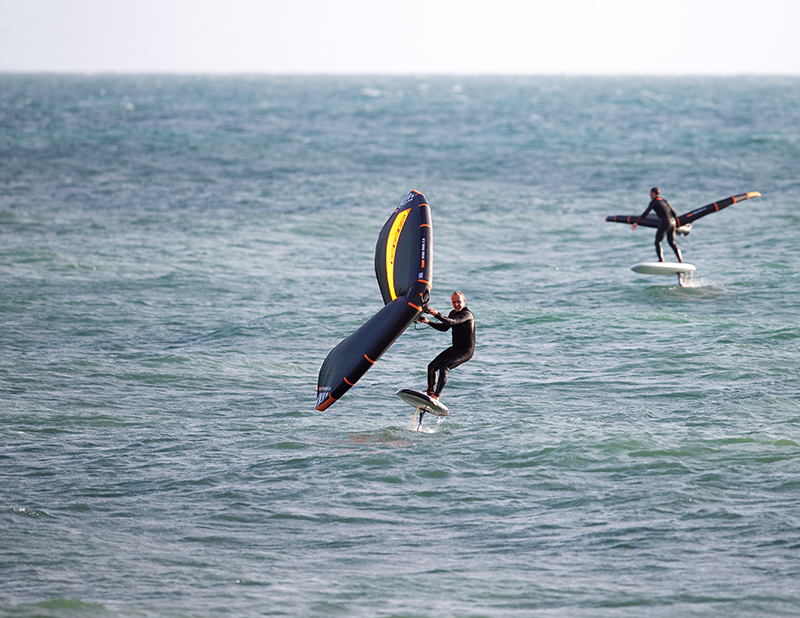
Opening your mind to future possibilities. Hydrofoiling is here to stay and it will make you happy …
// What next for RRD? Year 25 was a big year for the obvious reasons. What are the headlines for year 26?
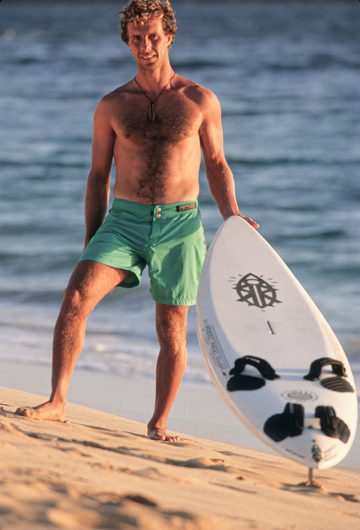
“A younger me in Makena beach. His second home from 1988 to 1993. These were my university years, with the classroom being Maui's north shore.”
We have been working on simplifying the lines, streamlining, getting a few less products in the line generally, just to make sure that people have more of an understanding of where the line is going and what you do to choose from our collection. I believe that watersports are going to go in that direction more and more, with less customization for riders, and more general products that are going to be crossover and hybrids between different sports. So I think that a guy that starts windsurfing might want to go to windfoiling or SUP foiling, or a guy that does SUP foiling might want to go to wingfoiling, and why not? And with foiling everything becomes more ‘one’. So it's always foiling, but there's a sail, there's a paddle, there's a wing, there's a kite… Then we have the classic boards that are ridden without the foil when the conditions are good, where you want to be able to learn something for example, so I think the foil is just an additional technology. It's potentially like what the electric engine has been doing to cars… In the past was the turbo, which might have been considered a new addition to the classic engines, and now we have electric engines with our cars. It would have been crazy to think about that about 10 years ago. Now it's very common to have it, and I think foiling is a little bit like the electric engine onto the classic car. So we have a new way of looking at watersports thanks to this beautiful new device, the hydrofoil.
This feature originally appeared in TheKiteMag #35. To subscribe, head here.
